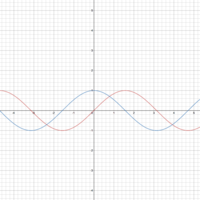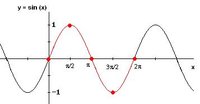Use a reliable, labeled graph of each to memorize the shape, intercepts and turning points. That is, the easiest way to draw a rough sketch of sine or cosine is from memory. For people who struggle to remember, I'd suggest taping enlarged copies to the wall where they study trig (worked for me).
View attachment 19047
Note some basic patterns.
The x-intercepts are multiples of pi (…-4pi, -3pi, -2pi, -pi, 0, pi, 2pi, 3pi, 4pi…). Plot those points first.
The turning points occur halfway between the x-intercepts (…-2½pi, -1½pi, -½pi, ½pi, 1½pi, 2½pi…). Plot those points next, alternating between peaks and valleys. Use improper fractions, instead of mixed numbers, when labeling the x-axis (pi/2, 3pi/2, 5pi/2).
The graph of sine passes through the Origin (the graph of cosine does not). Near the Origin, the graph looks like y=x. Use these facts to begin your rough sketch, by drawing a line upwards through the origin with slope 1 and then curve to meet the first turning point -- the peak at (pi/2,1). The curve goes down through the first x-intercept to the right of zero (pi,0) with slope -1. Continue to the next turning point -- the valley at (3pi/2,-1), then back up to the second x-intercept (2pi,0). That is one period.
The graph of cosine is identical to the graph of sine shifted pi/2 units to the left.
?


